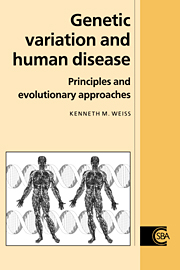Book contents
- Frontmatter
- Contents
- Frontispiece
- Preface: what is this book all about?
- Notational conventions used in this book
- List of abbreviations
- Part I Genes and their expression
- 1 What is a gene?
- 2 The logic of the genome
- 3 Concepts of frequency and association in populations
- 4 Genes and phenotypes in populations
- Part II Introduction to genetic epidemiology: inference from observational data
- Part III Evolution: the time dimension in populations
- Part IV Modification of the inherited genotype: the time dimension in individuals
- Afterwords: towards a unified general model
- References
- Index
4 - Genes and phenotypes in populations
from Part I - Genes and their expression
Published online by Cambridge University Press: 05 June 2012
- Frontmatter
- Contents
- Frontispiece
- Preface: what is this book all about?
- Notational conventions used in this book
- List of abbreviations
- Part I Genes and their expression
- 1 What is a gene?
- 2 The logic of the genome
- 3 Concepts of frequency and association in populations
- 4 Genes and phenotypes in populations
- Part II Introduction to genetic epidemiology: inference from observational data
- Part III Evolution: the time dimension in populations
- Part IV Modification of the inherited genotype: the time dimension in individuals
- Afterwords: towards a unified general model
- References
- Index
Summary
In short, in matters vegetable and animal, the very model of a modern Major-Gene …
Mutated from W. S. Gilbert, Pirates of PenzanceHow can the almost unimaginable amount of genetic variation, arising in an almost unimaginably variable environmental context, be related to specific phenotypes? This chapter extends the concepts of frequency and association developed in the previous chapter, to provide the basic concepts needed for a genetic model of how genes may affect a trait and how they act. Such models take advantage of the special constraints that billions of years of evolution have placed on traits controlled by genes.
Frequency concepts for genetic traits
The prevalence of a genetically related trait in a population depends on the amount of genetic variation that affects it.
Allele and genotype frequencies
The most fundamental quantitative variable in population genetics is the allele frequency (often carelessly called the ‘gene’ frequency), a prevalence measure. If, among the 2N copies of a given gene in a population of N diploid individuals, ni are allele i, then the frequency of that allele is defined as pi = ni/2N. There is no theoretical restriction on the number of alleles that can exist at a locus, but their frequencies must sum to 1. Thus, if one allele is very common, others must be correspondingly rare.
- Type
- Chapter
- Information
- Genetic Variation and Human DiseasePrinciples and Evolutionary Approaches, pp. 52 - 66Publisher: Cambridge University PressPrint publication year: 1993



